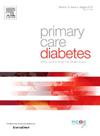Enhancing the follow-up for patients with type 2 diabetes mellitus using a proactive scheduling computer tool: A paired cohort study in primary care
IF 2.6
4区 医学
Q3 ENDOCRINOLOGY & METABOLISM
引用次数: 0
Abstract
Aim
To assess the impact of an electronic scheduling tool (Planificat) on the management of type 2 diabetes mellitus (T2DM) in primary care settings.
Methods
This paired cohort study used data from the Catalan primary care electronic health records. The intervention cohort, using Planificat, included all patients aged 15 years or older with T2DM and was matched 1:1 with a control cohort. The study period lasted one year. Mixed general linear models estimated Odds Ratios (OR) and 95 % confidence intervals (95 %CI) for primary outcomes, including T2DM clinical tests (LDL cholesterol, HbA1c), visit frequency, and non-attendance rates.
Results
A total of 51,619 patients (mean age 68.3 years, 42.1 % of female sex) and their paired controls were included. In the primary analysis, significant increases were observed in the Planificat group (N = 18,542) regarding several measures: cholesterol tests performed (83.5 % vs. 75.4 %; OR: 1.65 [95 %CI: 1.57–1.74]), HbA1c tests performed (83.7 % vs. 75.4 %; OR: 1.7 [95 %CI: 1.61–1.79]), and electrocardiograms (65 % vs. 52 %; OR: 1.72 [95 %CI: 1.65–1.8]). Additionally, there was a 36 % increase in patients achieving HbA1c levels < 8 % (OR: 1.36 [95 %CI: 1.3–1.42]). Statistically significant improvements of 30 % and 40 % were also observed in foot and retinopathy screenings, respectively. Face-to-face visits with general practitioners and non-attendance rates remained comparable between cohorts, while face-to-face nurse visits increased by 7 %.
Conclusions
Planificat significantly improved T2DM management indicators, promoting proactive scheduling and enhancing follow-up in primary care without impacting face-to-face visits. These findings support its integration as a complementary strategy for optimizing chronic disease management.
利用主动排班计算机工具加强对 2 型糖尿病患者的随访:基层医疗机构的配对队列研究。
目的:评估电子排班工具(Planificat)对初级保健机构2型糖尿病(T2DM)管理的影响。方法:这项配对队列研究使用了来自加泰罗尼亚初级保健电子健康记录的数据。使用Planificat的干预队列包括所有年龄在15岁或以上的T2DM患者,并与对照队列进行1:1匹配。研究期为一年。混合一般线性模型估计了主要结局的优势比(OR)和95% %置信区间(95% %CI),包括T2DM临床试验(LDL胆固醇、HbA1c)、就诊频率和不出勤率。结果:共纳入51,619例患者(平均年龄68.3岁,女性占42.1 %)及其配对对照。在初步分析中,Planificat组(N = 18542)在几项测量中观察到显著增加:进行胆固醇测试(83.5% %对75.4 %;OR: 1.65[95 %CI: 1.57-1.74]),进行HbA1c检测(83.7 % vs. 75.4 %;OR: 1.7[95 %CI: 1.61-1.79])和心电图(65 % vs. 52 %;Or: 1.72[95 % ci: 1.65-1.8])。此外,达到HbA1c水平的患者增加了36% %。结论:Planificat显著改善了T2DM管理指标,促进了主动安排和加强了初级保健的随访,而不影响面对面就诊。这些发现支持将其整合为优化慢性疾病管理的补充策略。
本文章由计算机程序翻译,如有差异,请以英文原文为准。
求助全文
约1分钟内获得全文
求助全文
来源期刊

Primary Care Diabetes
ENDOCRINOLOGY & METABOLISM-PRIMARY HEALTH CARE
CiteScore
5.00
自引率
3.40%
发文量
134
审稿时长
47 days
期刊介绍:
The journal publishes original research articles and high quality reviews in the fields of clinical care, diabetes education, nutrition, health services, psychosocial research and epidemiology and other areas as far as is relevant for diabetology in a primary-care setting. The purpose of the journal is to encourage interdisciplinary research and discussion between all those who are involved in primary diabetes care on an international level. The Journal also publishes news and articles concerning the policies and activities of Primary Care Diabetes Europe and reflects the society''s aim of improving the care for people with diabetes mellitus within the primary-care setting.
 求助内容:
求助内容: 应助结果提醒方式:
应助结果提醒方式:


